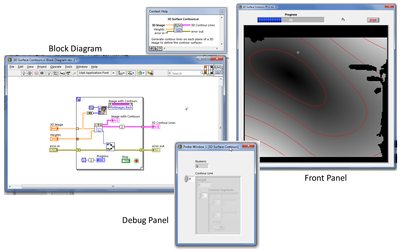-
Analysis & Computation
305 -
Development & API
2 -
Development Tools
1 -
Execution & Performance
1,027 -
Feed management
1 -
HW Connectivity
115 -
Installation & Upgrade
267 -
Networking Communications
183 -
Package creation
1 -
Package distribution
1 -
Third party integration & APIs
289 -
UI & Usability
5,455 -
VeriStand
1
- New 3,060
- Under Consideration 4
- In Development 4
- In Beta 0
- Declined 2,639
- Duplicate 711
- Completed 336
- Already Implemented 114
- Archived 0
- Subscribe to RSS Feed
- Mark as New
- Mark as Read
- Bookmark
- Subscribe
- Printer Friendly Page
- Report to a Moderator
The Block Diagram should be the central VI component (not the Front Panel)
From considering a number of other ideas (see below), I want to suggest that the Block Diagram is the only item initially created when defining a VI, and becomes the place where ALL VI functionality is defined. The BD is the place where dataflow is specified and the functionality of the VI is determined. So it makes sense that the con-pane should be linked to the BD rather than the FP -- it defines the data interface between calling VIs to this VI. Similarly the icon often provides a visual clue to the VI functionality, rather than its FP look. So both con-pane and icon are natural components of the BD window.
From the BD, it should then be possible to define one, or more, Front Panels which provide user interfaces to the data. These FPs may contain some or all of the variables in the con-pane (why ever show Error In/Out?), along with some or all of any other controls/indicators used in the block diagram. In fact, the Probe Window is already almost an additional FP - just allow several data indicators to be grouped on a single window, and you essentially have a Debug Panel. It would be great to be able to save the Probe window (or several of them) with a VI.
Yes, there will be problems, not least that I'm sure some existing code assumes that an FP (and only one) exists if a BD exists. And that every control/indicator must have a FP representation.
Here's a rough mockup (though the Probe points could be "virtual indicators" instead):
Other related ideas:
Be able to link to the connector pane in Block Diagram
We need to uncouple the "edit mode" FP size from the "run mode" FP size
and one trying to address the same concerns, but in a way I don't like:
You must be a registered user to add a comment. If you've already registered, sign in. Otherwise, register and sign in.


Changing status back to 'New' since LabVIEW NXG was discontinued.